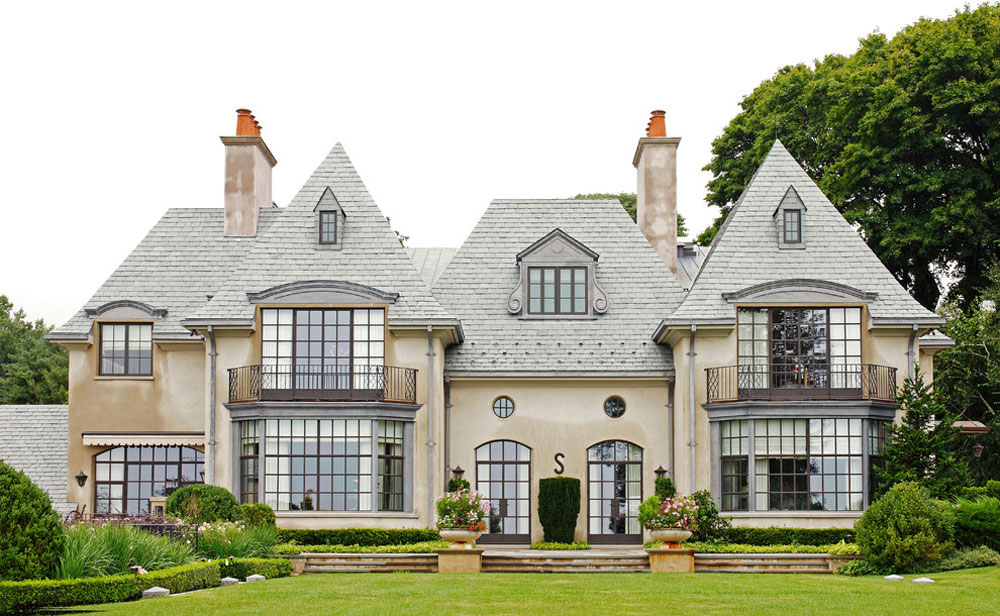Advertisement
What is a mansard roof? A mansard roof is a four-sided gambrel-design hip roof defined by two slopes on every one of its own sides with the lower pitch, punctured by dormer windows, at a steeper angle compared to the upper.
It’s also called a French roof or a curb roof. These steep roofs create an extra floor known as a garret and also reduces the height of the roof for a certain number of habitable stories. From up close, the top slope of a mansard roof may not be visible from ground level.
Mansard roofs are great for modern buildings. They’re used a lot more than you realize. Of course, mansard roofs aren’t without their issues. Although usually more expensive and harder to build, the owner of Dawson Property Management believes that having some additional space for storage or even living without taking up more square footage is very useful.
Take a look at our guide to mansard roofs. We detail what makes a mansard roof unique, the advantages and disadvantages of having one, how the structure should work, how to get one, and some variations on the design.
Identifying a Mansard Roof
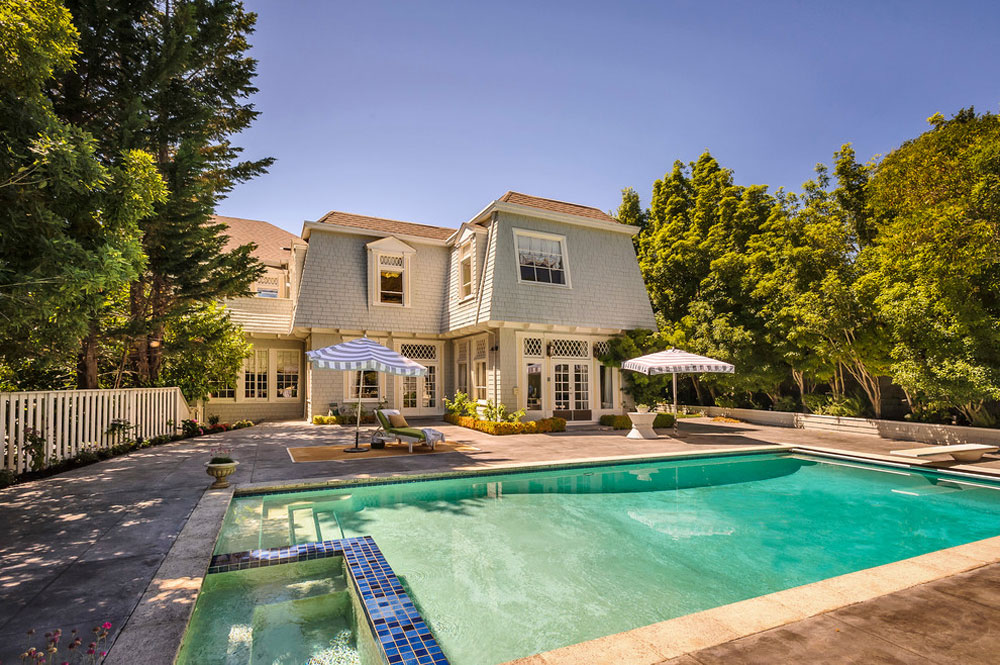 Image source: Dennis Mayer – Photographer
Image source: Dennis Mayer – Photographer
The first mansard roof is often credited to Pierre Lescot and appeared on a section of the Louvre built around 1550. Mansard roofs were popularized in the early 17th century by Francois Mansart (1598-1666), to whom they also owe their name.
Mansart was an accomplished architect from the French Baroque period. The mansard house became particularly popular during the Second French Empire (1852-1870) of Napoleon III. Mansard is also used for the garret (or loft) space itself, not just the shape of the roof. It is also used in Europe to mean a gambrel roof, which is the roof shape used for many barns.
Mansard roofs are easily mistaken for other kinds of roofs. A mansard roof’s double pitch and steep sides are shared with many other kinds of roofs. The upper pitch is barely visible to anyone standing on the ground, which can lead observers to misclass a single-plane roof with steep sides for a mansard roof or vice versa.
The gambrel roof used for many American barns is closely related to the mansard roof and shares many characteristics. Both are classed as curb roofs—pitched roofs that slope away from a ridge in two consecutive planes. The curb is the horizontal plank right below where the two roof surfaces join.
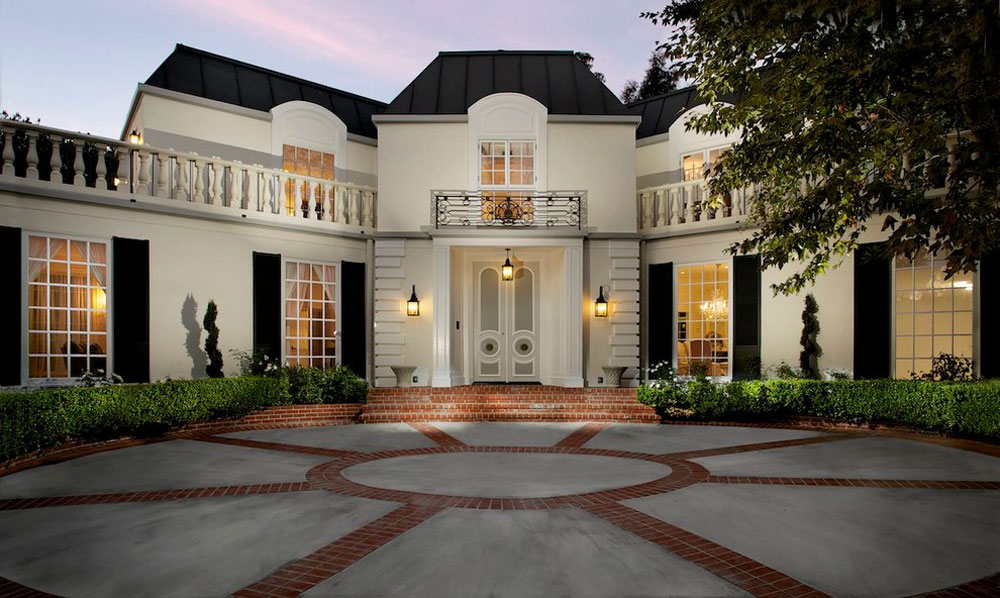 Image source: Michael Kelley Photography
Image source: Michael Kelley Photography
The mansard, however, is a curb hip roof, since it has gradients on all sides. The gambrel roof is a curb gable roof since it has pitches on just two sides. The most major difference between the two is that gambrel roofs end in long sharp points in the principal roof beam, while mansard roofs always have a low pitch.
The gambrel roof has this feature in order to help with water drainage and snow loading, which is more of a concern for barns in locations where this roof design is frequently used.
In France and Germany, there is no differentiation made between gambrel roofs and mansard roofs. They are both called mansard roofs. The French word “mansard” can be used as a term for the garret living space or loft in mansard buildings as well as for this type of roof itself.
French roof is another term often used for a mansard roof. However, a French roof is an American version of a mansard roof. It has larger lower pitches and they are almost perpendicular compared to the top pitches.
The Advantages of a Mansard Roof
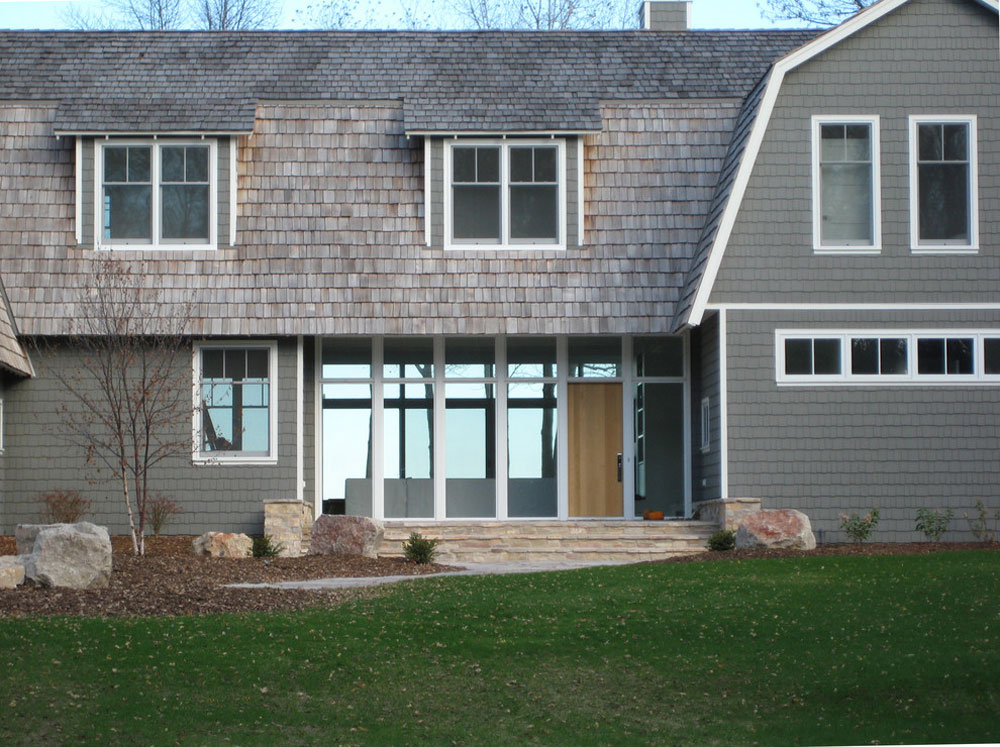 Image source: Searl Lamaster Howe Architects
Image source: Searl Lamaster Howe Architects
- Mansard roofs maximize the amount of interior space that can actually be used. They offer an easy way to add one or more stories to a new or existing building without needing to use any more material. It is also used to create more decorative buildings. The concave or convex curvature makes for a unique decorative opportunity and the dormer windows can be made to look very elegant.
- The very first incline of a mansard roof is very high. This incline can easily function as a wall if you decide to build another floor on top of the house. Because of this, a mansard roof makes for a very versatile choice and allows for later additions to be less expensive. If you’re a young family building their first home, a mansard roof is a great choice, since you won’t have to go through the hassle and expense of a larger home if you plan on growing. Extra rooms can more easily be added on.
- Mansard roofs offer a noticeably larger amount of living space. Because all four sides are sloped in a box shape, you can easily have a spacious attic or loft area. You can even set it aside as an extra bedroom if you want.
The Disadvantages of a Mansard Roof
- Mansard roofs are more expensive than many other kinds of roofs. They also take longer to build. Construction of a mansard roof is a complicated process. A construction company needs to hire more workers and use more materials in order to build it. Regular saddleback roofs require much less money, labor, and time. The cost is often too much for many homeowners, especially if they have a very tight budget. The extra space may not be worth that much to you. Sometimes just adding an entire extra story may be more worth your time and money.
- Mansard roofs don’t hold up all that well under heavy rain and heavy snow. The second, more level incline of a mansard roof doesn’t drain very well when there’s overflow. Large amounts of water can end up standing on your roof for a pretty long period of time. This can cause all sorts of damage. Your roof can leak or warp. Mold can start growing. This sort of damage can be extremely extensive and repairs can cost quite a lot. If you live in an area with heavy seasonal rains or where there are intense snow storms, a mansard roof is probably not for you.
- Maintenance for mansard roofs is very intensive. They need a lot more upkeep than gable and saddleback roofs. The flatter portion of a mansard roof gathers dirt, dust, leaves, and other things much more easily than many other roofs. This makes mansard roofs more vulnerable to damages. The cost for maintenance is not too much or too difficult, it is an extra cost you won’t have with other kinds of roofs. You do need to make sure maintenance is done regularly in order to prevent catastrophic damage, so skipping out on it is not a good idea.
How is a Mansard Roof Structured?
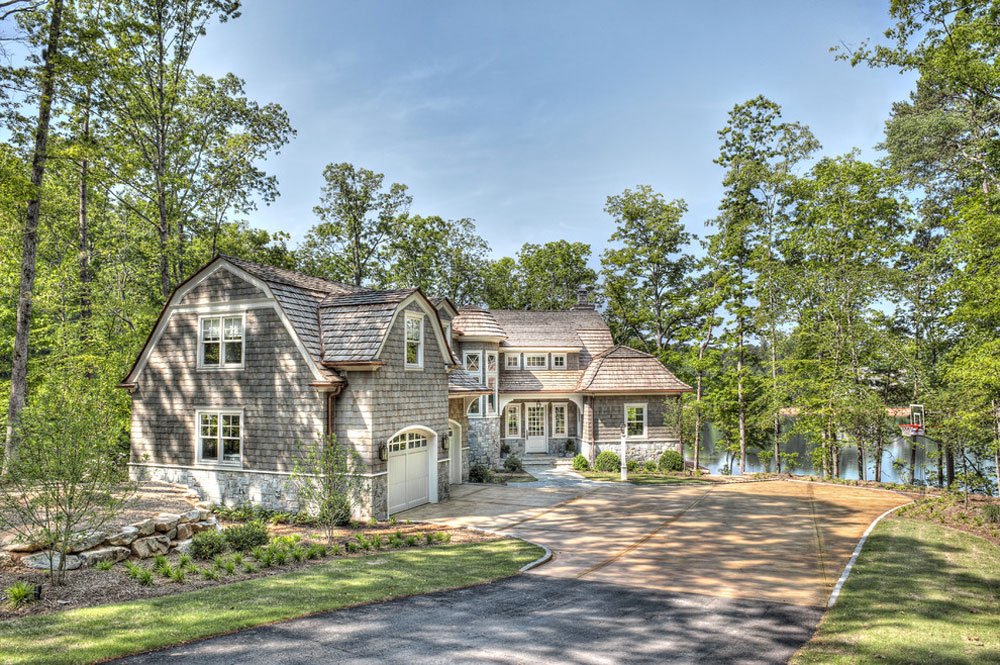 Image source: Gabriel Builders Inc.
Image source: Gabriel Builders Inc.
Mansard roofs are usually based on a standing joint or batten seam form of construction. The lower ends of the frying pans are hooked over a side strip to form a drip.
The ends can also attach to the base flashing when an adjustment in the roof incline occurs. There are variations of these details—and all the others—but we’re only going to cover the way things usually happen.
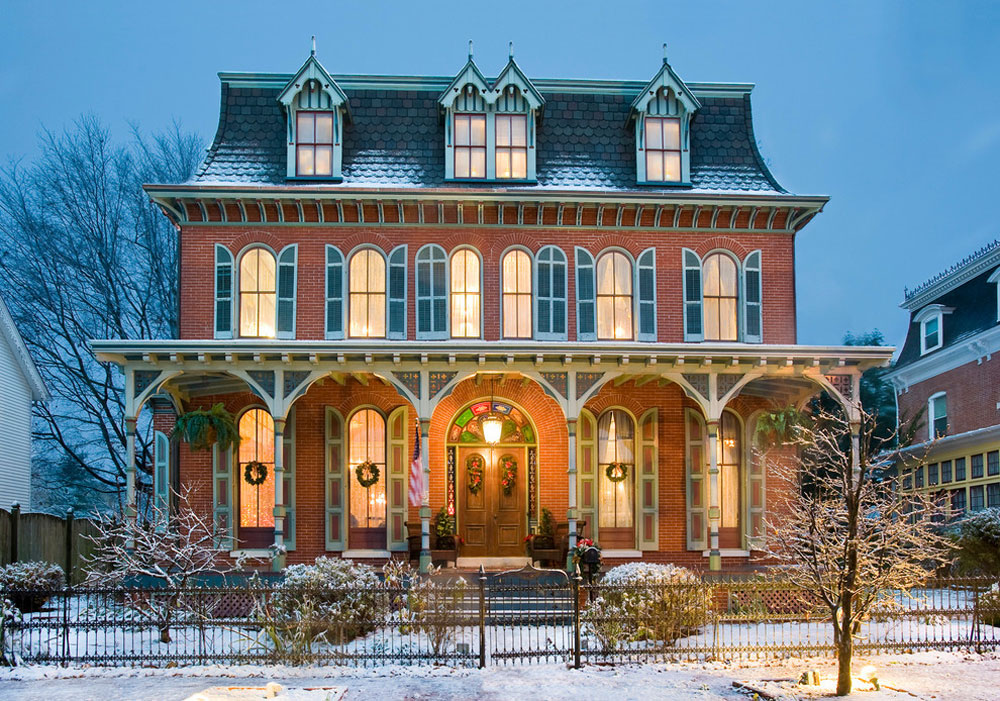
Image source: Jay Greene Photography
The most common detail for the top edges of the frying pans is for them to fold out the elevation of the batten or standing joint and terminate with a ¾ inch layer. Hooked over this layer is the reduced side of the gravel stop or dealing blinking.
Because mansard roofs usually make use of vertical or almost vertical surfaces, they typically don’t need special arrangements for low slope standing or batten seams. Decorative battens can be added in the same way as they are added to chevron roofs.
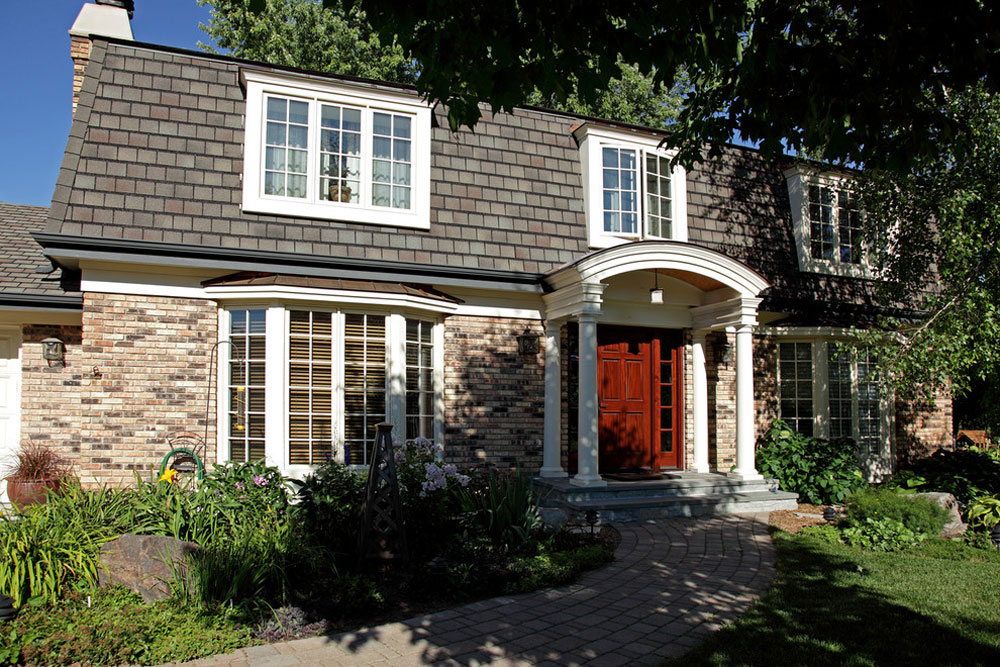 Image source: Knight Construction Design Inc.
Image source: Knight Construction Design Inc.
If you have standing seams or battens are continuing over the top edge of the mansard, you’ll have to take a few more steps. The frying pans should be constant over the leading edge.
The upstanding legs of the standing or batten seams will have to be slit where they bend. After bending, small pieces of copper need to be soldered over the legs to finish the connection. The seams will then ended in the normal, traditional fashion.
If you’re adding wooden decking, you’ll need a continual sheathing substratum that is suitable for the roof.
Coping Cover
The top side of the pans should be folded up to the elevation of the batten or standing joint, then curved down ¾ of an inch. The coping cover is hooked over this side, creating a drip.
Gravel Stop
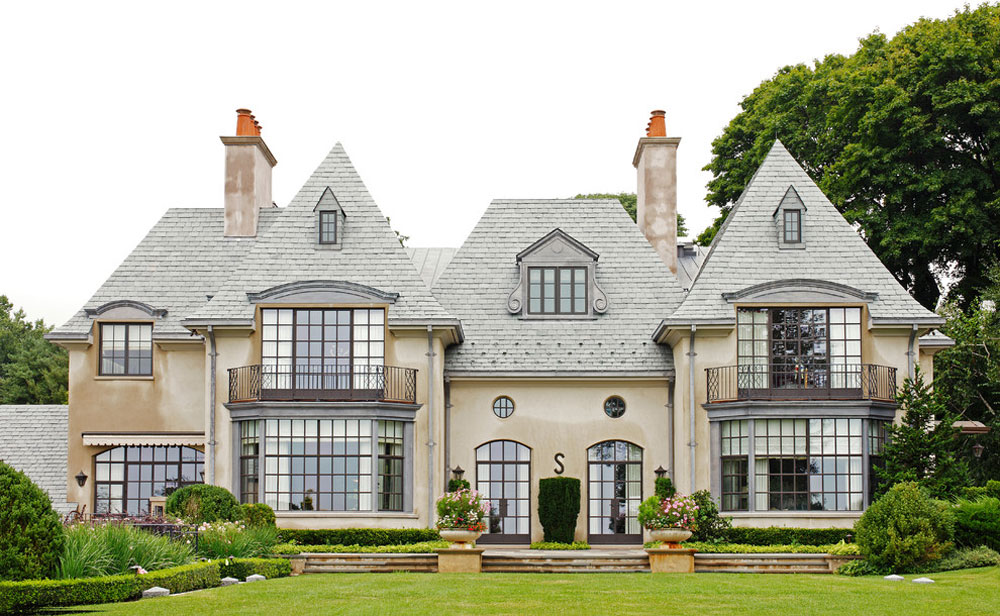 Image source: The Outdoor Lights
Image source: The Outdoor Lights
The leading edge of the frying pans have gravel stops folded up to the frying pan edge.
Base of a Mansard Roof
The bottom side of the frying pans should be hooked over the side strip to create a drip. The horizontal measurement of the side strip should not exceed 4 inches if it is not secured to the soffit.
Modification of the Mansard Roof Slope
At the lower roof, the standing joints should be laid flat 8 inches from the roof break, folded up ¾ of an inch and secured with copper cleats spaced 12 inches on center. The frying pans should be continual from the face of the mansard over to the side onto the roof. The upstanding legs of the joints must be slit where they are bent.
After these legs are bent, small pieces of copper need to be soldered to the rear end of these legs. Batten caps should then be added. Their legs should be slit and firm where they are bent, a deviation from the normal procedure.
How to Build a Mansard Roof
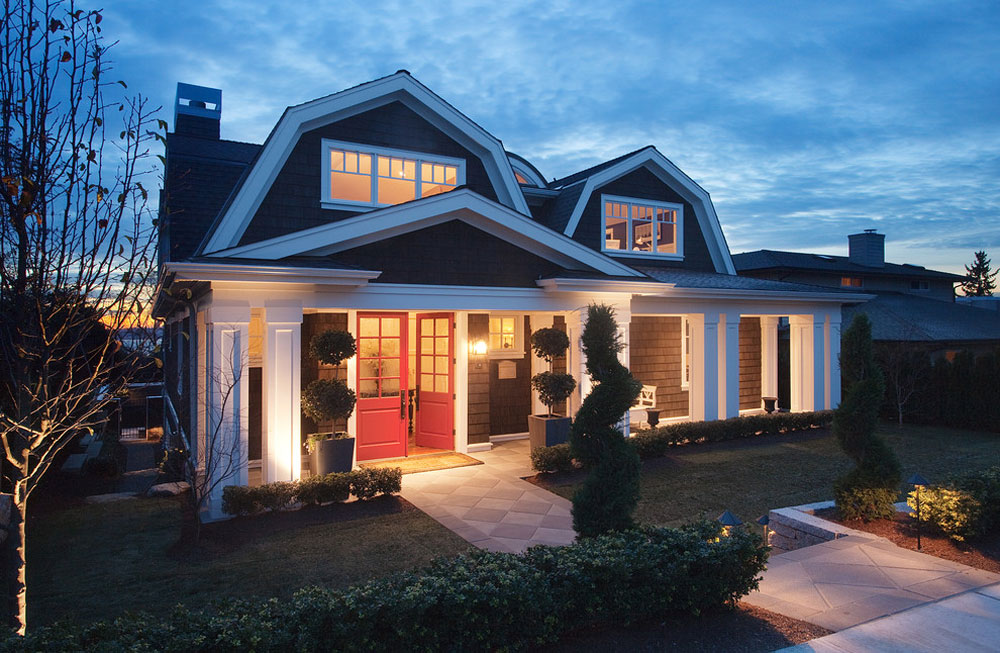 Image source: Kristi Spouse Interiors
Image source: Kristi Spouse Interiors
1. Making Decisions and Planning
At this point, you will be choosing a blueprint for your roof, learning what building codes you need to follow, contacting roof specialists to learn what details you need to know, buying materials, hiring labor, and taking out insurance.
This is the point when you can anticipate many issues and take steps to prevent them. Good planning is vital to any construction project.
2. Preparing the Build Site
Buy the area you plan to build on. Use a giant table or section off an area to make sure that all materials are in one section. Make sure they are well organized and easily accessible.
Make sure you cover all plants in the area, as well as any tools and materials, with plastic sheets or tarpaulins to make sure they aren’t damaged during construction. Be sure to label materials so that it’s clear what they’re for. Secure expensive items so they are not stolen when no one is at the site.
3. Placing the Rafters
Use normal rafters and fix them to a ridge board. Use nails to fix them in place. After this is done, boost the ridge and then use nails to fix the various other rafters right into their location.
The outside rafters should be positioned so that the birdsmouth joint gets on a plane with the highest possible plate of the wall. When the specific position has been achieved, use nails to tighten the rafters into place. Use the exact same procedure on the three staying sides.
Make sure you maintain good safety procedures as you do this. Have everyone wear hard hats, gloves, and eye protection.
4. Remaining Common Rafters
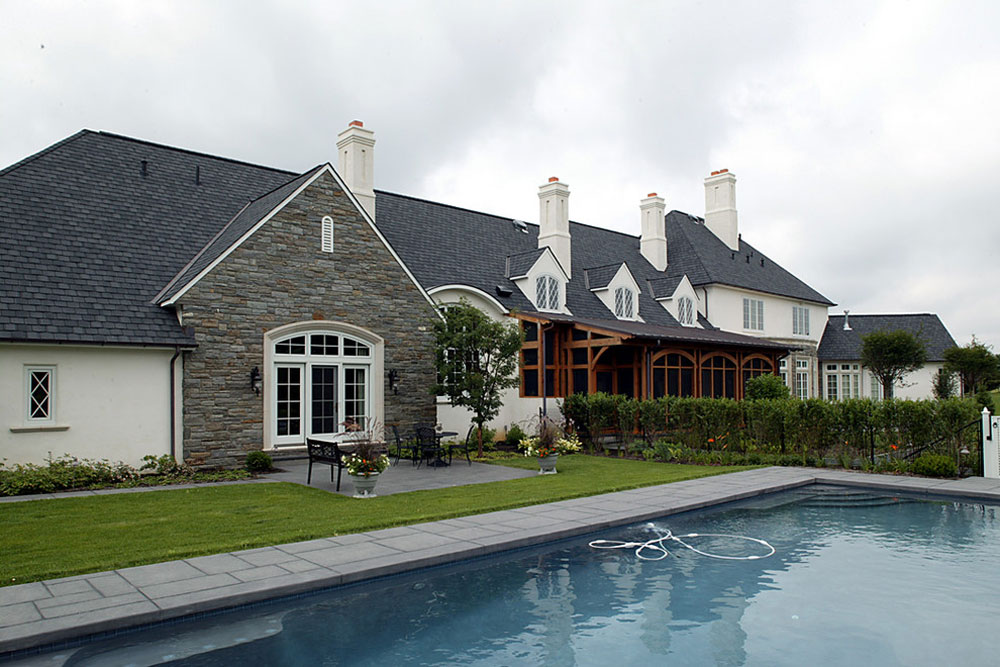 Image source: Dewson Construction Company
Image source: Dewson Construction Company
The common rafters left over need to be put into place. They should be nailed right into the area in order to make sure they have limited motion and are positioned safely. Check everything before you move on to the next step. It will become harder to make fixes as you move on.
5. Ceiling Beams and Sheathing
The ceiling beams should be treated with care. Use nails to secure them in place as well as make sure they aren’t loose. This will ensure that there is no damage later on. After this has been taken care of, cover the area with sheathing. Make sure you double check everything before you cover it.
6. Upper Extension
This is the raised prolonged area that creates the top expansion of the mansard roof. It needs to be built using upright rafters. These vertical rafters need to be placed inside the boundaries of the ridge board. Use these rafters both inside and outside of the structure to make it more durable. They will also help you as you go along.
7. Sheathing and Shingling
Use collar ties and fascia for the roof before you start going through the sheathing procedure. The sheathing needs to be affixed to the rafters with nails.
Any area where there are valleys and vents should be covered utilizing with flashing. After you’ve done this, lay the undercoating material over the whole surface area, then cover it with roof shingles.
Mansard Roof Design Variations
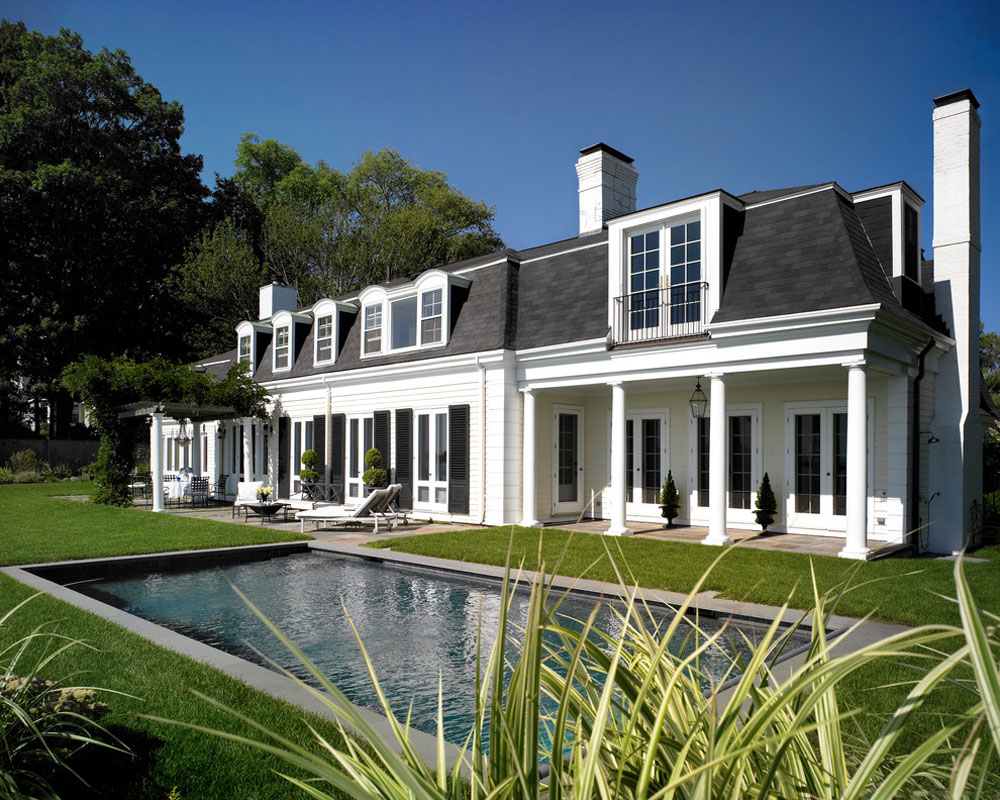 Image source: John P. Margolis, AIA
Image source: John P. Margolis, AIA
There are several design modifications you can make to a mansard roof to change how it looks and functions. These have been in use for as long as the mansard roof design has been around.
They each have their pros and cons. Make sure you consider the structure of your home and the nature of your environment before you settle on one of these modifications.
- Concave
A concave style mansard roof curves inward or can occasionally flare. Sometimes, these roofs have a steep angle on their bottom slopes. The concave mansard roof was very popular in the second half of the 19th century. They can be found in large buildings and mansions from that period.
Because the top of a mansard roof is flat, heavy snow accumulation can cause cracks. These cracks will widen and eventually leak. A large amount of rain will pool at the top and erode the roof.
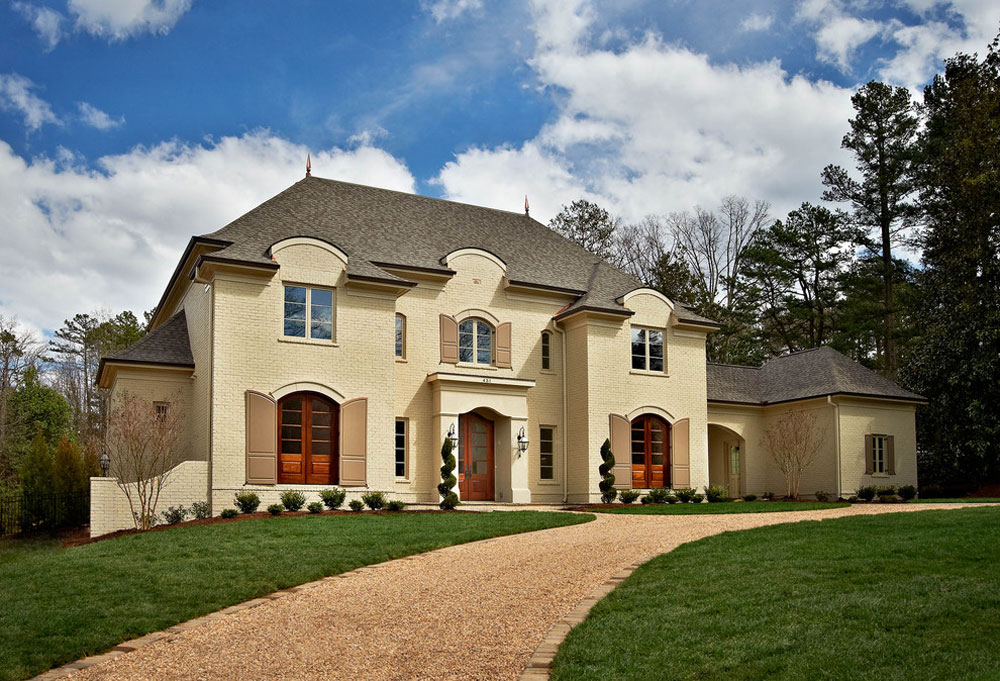 Image source: dustin.peck.photography.inc and Kingswood Custom Homes
Image source: dustin.peck.photography.inc and Kingswood Custom Homes
The best thing to do if you have a concave mansard roof is to check the roof thoroughly for damage at least yearly. Repair any damage immediately to make sure that it does not get worse. While roof inspections and repairs can be costly, more extensive damage will be even more expensive.
- Convex
A convex style mansard roof has an outward curve on its lower slope. Convex mansard roofs can be shaped like the letter S or can have a bell shape.
Both of these shapes allow for there to be more interior roof space without requiring any additional levels to be added to the house. Mansard roofs with convex shapes are often found on courthouses, especially if they have elaborate towers.
If your home has a convex mansard roof, make sure that you remove any tree branches that hang over the roof as well as those growing within 5 feet of the house.
This will ensure that tree branches will not fall onto the flat portion of the roof. Any branch that falls there could end up sitting there for quite a while until you can remove it. These fallen branches can easily cause damage to the roof and cost a lot for repairs.
- Straight
A straight mansard roof has a slight slope on the upper panel. This slight slope is not usually visible for anyone standing at ground level. These roofs are designed to feature dormer windows in the lower slope. Sometimes this slope can be almost vertical. These dormers provide light, ventilation, and a bit of extra interior space.
One of the disadvantages of having a straight mansard roof is that the weight of snow gathering on the roof can cause cracks. The weight which will eventually create cracks and leaks in the roof.
When repairing an old roof, bring the original piece into the store with you. Sometimes roof parts are no longer being made, so you may have to look for a match among more recent parts to get as close a match as possible.
Modern Mansard Roofs
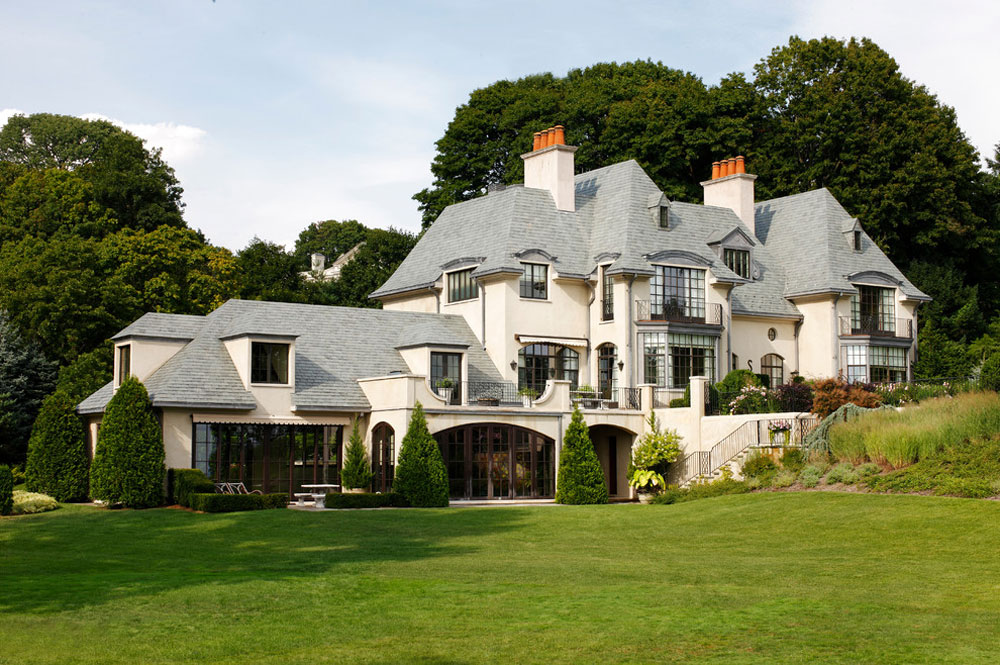 Image source: The Outdoor Lights
Image source: The Outdoor Lights
Mansard roofs are mostly found on much older homes, but it’s possible to build a more updated version designed to mitigate some of the design’s problems. Modern materials are often more durable and resistant to water damage. High-quality insulation will help prevent damage to a mansard roof.
Using a mansard roof design will lend a new building a vintage look. It’s also a great way to maximize the amount of usable space in your new home. You can use shingles to mimic traditional Victorian design, or you can use more modern roof tiles to help the house fit into the neighborhood.
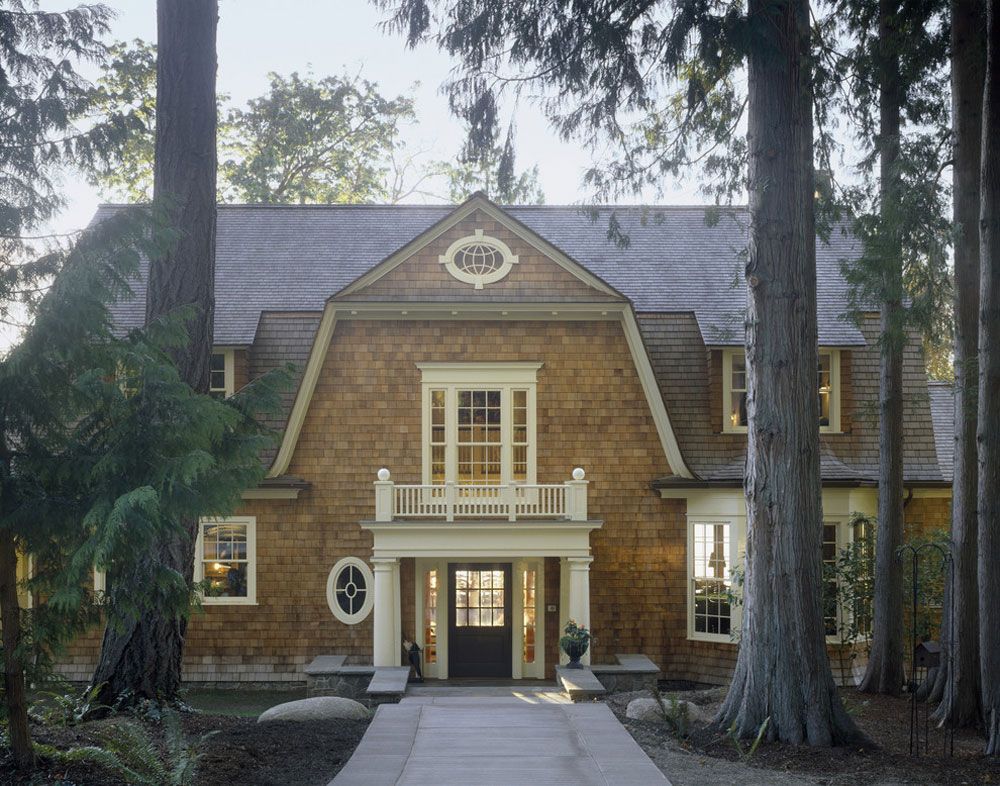 Image source: Conardromano
Image source: Conardromano
There has recently been a trend towards installing solar panels on roofs to make homes both more energy efficient and environmentally friendly.
If you live in an area that receives a lot of sunlight, consider adding solar panels to a mansard roof. This makes great use of an area that sees a lot of sunlight and is a great modern twist on this classic roof design.
Mansard Roof Interiors
 Image source: Christopher A Rose AIA, ASID
Image source: Christopher A Rose AIA, ASID
The addition of the loft or gannet is the primary reason to add a mansard roof to a home. These lofts are great for storage, but if you want to use them as living spaces, you’ll need to make sure they are appropriately insulated.
Make sure you look up the local regulations about living spaces. Many local governments give specifications about ventilation, fire alarms, and accessibility for areas where people live. Be sure to follow them. You don’t want your swanky new loft to become a death trap.
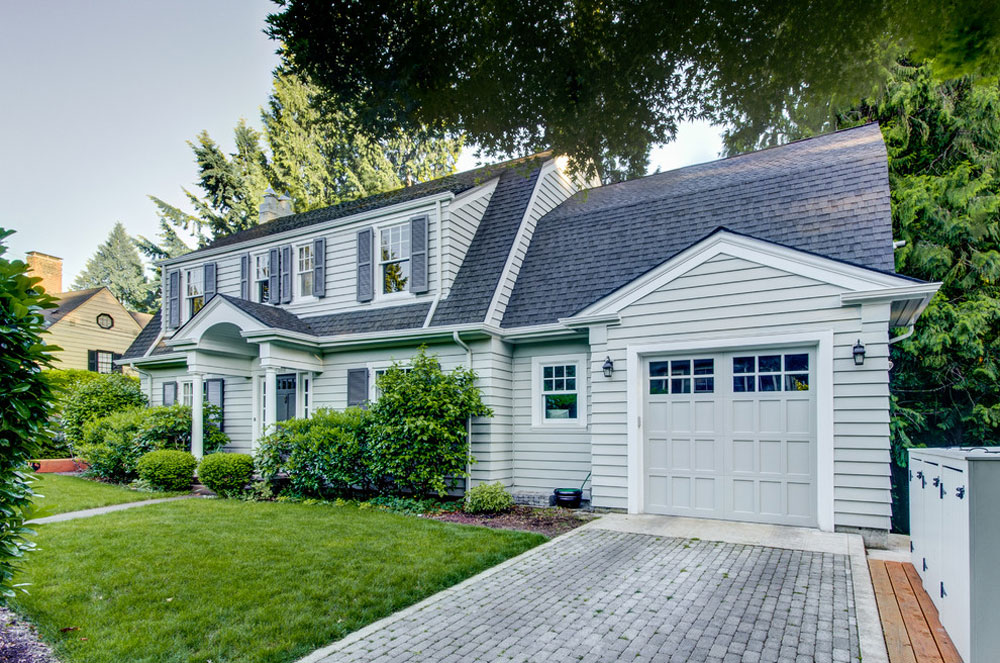 Image source: The Works
Image source: The Works
You have a lot of options for how to structure the loft created by your mansard roof. You can have it sealed off as a separate floor, or create an opening to the floor(s) below.
It’s a great opportunity to make your home unique. Use it as an extra bedroom or as a man cave. Store your holiday decorations or create a small rental space to help your budget. There are a lot of possibilities out there. Work with an architect to see what you can pull off with your budget and timeline.
Ending thoughts on having a mansard roof
Is a mansard roof right for your new home? It really is a matter of what you’re looking, what kind of budget you have, and where you live. Like everything else when it comes to designing and building the home of your dreams, carefully consider every option available. Don’t be afraid to look to designs of the past like mansard roofs.

